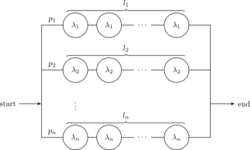Hyper-Erlang distribution
From HandWiki
Short description: Continuous probability distribution
In probability theory, a hyper-Erlang distribution is a continuous probability distribution which takes a particular Erlang distribution Ei with probability pi. A hyper-Erlang distributed random variable X has a probability density function given by
- [math]\displaystyle{ A(x) = \sum_{i=1}^n p_i E_{l_i}(x) }[/math]
where each pi > 0 with the pi summing to 1 and each of the Eli being an Erlang distribution with li stages each of which has parameter λi.[1][2][3]
See also
References
- ↑ Bocharov, P. P.; D'Apice, C.; Pechinkin, A. V. (2003). "2. Defining parameters of queueing systems". Queueing Theory. doi:10.1515/9783110936025.61. ISBN 9783110936025.
- ↑ Yuguang Fang; Chlamtac, I. (1999). "Teletraffic analysis and mobility modeling of PCS networks". IEEE Transactions on Communications 47 (7): 1062. doi:10.1109/26.774856.
- ↑ Fang, Y. (2001). "Hyper-Erlang Distribution Model and its Application in Wireless Mobile Networks". Wireless Networks (Kluwer Academic Publishers) 7 (3): 211–219. doi:10.1023/A:1016617904269.
 |


